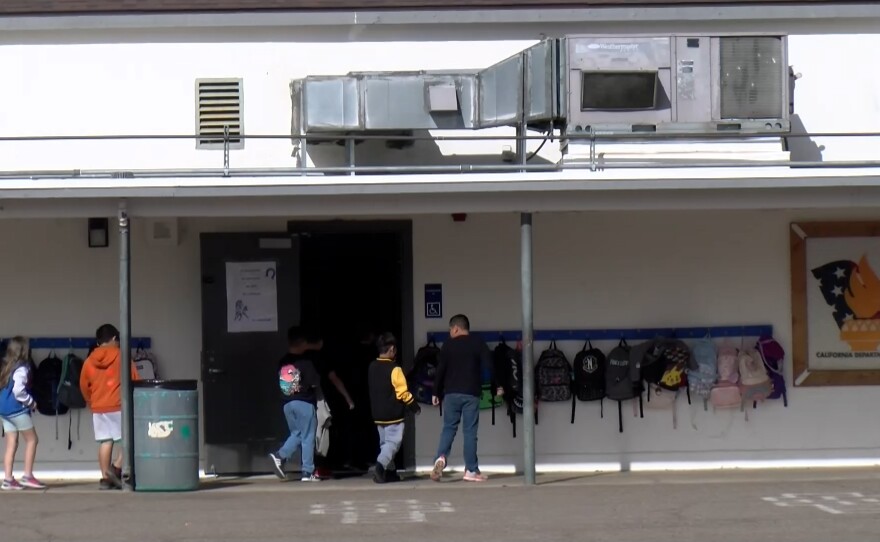Chris Gunnett attended Ramona Elementary School as a kid. Now, he’s the principal. On a recent tour of the school’s buildings, he focused on a wing of portable classrooms.
“Several of the portables here on campus are 40-plus years old,” he said.
District leaders say the useful life of portable classrooms is usually around 20 years. One portable’s roof is so damaged that students no longer use it. Gunnett pointed to the ceiling.
“We do have a gap here,” he said. “The light is actually coming through the roof.”
The school uses this portable for storage now. Gunnett said they have to move supplies away from the gap when it rains.

Water has already seeped into the school’s oldest building, which Gunnett thinks was built in the early 1900s. He pressed a finger into wood near the bottom of an outside wall.
“You've got a lot of water damage, especially down below here,” he said. “The substructure here, you can see that it's soft.”
In November, 54.5% of Ramona voters rejected a $26.7 million school bond measure. District leaders proposed using the funding it generated to replace portable classrooms, improve career technical education facilities and upgrade plumbing and fire alarm systems.
It’s the seventh bond measure to fail in the district since 1986, according to Superintendent Brian Thurman.
“We have to shift our focus to our current resources,” he said. “Unfortunately, that means allocating larger amounts of the funds we do get toward facilities.”
The district is facing a $9 million structural deficit this year, according to a district spokesperson. Thurman said they spent $2 million over the last two years on roofs.
“That was general fund dollars that could have been spent on all kinds of things — instruction, students, playground equipment, lots of things,” Thurman said.
Local bonds are also key to accessing school construction funding from the state. This year, California voters approved Prop. 2, replenishing the state’s pot of money for school repairs.
A consultant told Ramona’s school board in October that the district was eligible for $31 million in matching grants from the state if the district could pay its share for modernization projects — almost $21 million total. Thurman said raising local funds through a bond was an opportunity to bring state tax money back to Ramona’s kids.
“This pot is created with all Californians’ — from the Oregon border down through San Ysidro — all of our tax dollars,” he said. “The real message that I wanted to get across is that Ramona has never taken advantage of that.”

The more districts can raise through local bonds, the more state matching funds they can get. Some advocates argue that this system is unfair to districts with lower property values or where voters don’t pass local bonds.
The San Francisco-based law firm Public Advocates has called the school facility funding system unconstitutional.
“The state's role should not be to replicate the wealth disparities with how they hand out the state dollars,” said John Affeldt, a managing attorney with the firm. “The state's role should be to counter or redress local wealth disparities with state dollars.”
Bonds get paid back by increasing local property taxes. Ramona’s would have gone up by $59 per $100,000 of assessed property value.
Four schools in the Ramona Unified School District, including Ramona Elementary School, have schoolwide Title I programs. That means at least 40% of its students qualify for free or reduced lunch.
Thad Kousser, a political science professor at UC San Diego, said the cost of living and inflation were at the top of voters’ minds this year. He said three things drive voter behavior on bonds.
“One, how people are feeling about their pocketbook and whether they want to open it up to government overall,” he said. “The second thing is what people are thinking about that government function. Do they like the direction of education in California? And the third is what they're hearing from the groups that take positions for and against these bonds.”
The Republican Party of San Diego County’s voter guide said it opposed all ballot measures that increased taxes. In San Diego County’s unincorporated areas, 40% of voters are registered as Republicans, 30% are Democrats.
“Voters rarely care about the size of either a bond or a tax increase,” Kousser said. “Either they believe in the cause and are willing to invest in it or not.”
The San Diego County Taxpayers Association supported the bond measure. It described the district’s needs as “immediate and urgent” but warned that it “may lack a sufficient tax base to adequately finance the needs expressed by its community.”
At Ramona Elementary School, Gunnett said the maintenance department works hard to keep its buildings functional. But newer buildings would have fewer emergency repairs and better prepare students for the future.
“We have a lot of pride here, that is for sure. People choose to come here. I chose to come here as well and be a leader at this school,” he said. “But it is that sense of pride when you do have a new school. Kids feel a little more connected.”
Thurman said the district will continue to use the money it has to pay for increasingly costly repairs as they come up.







